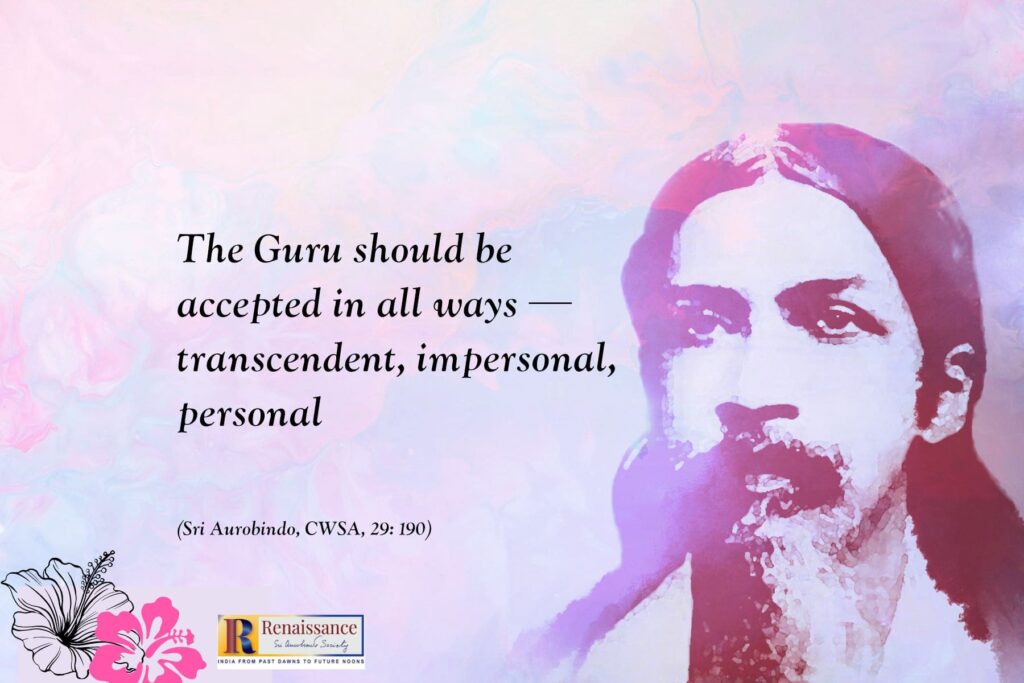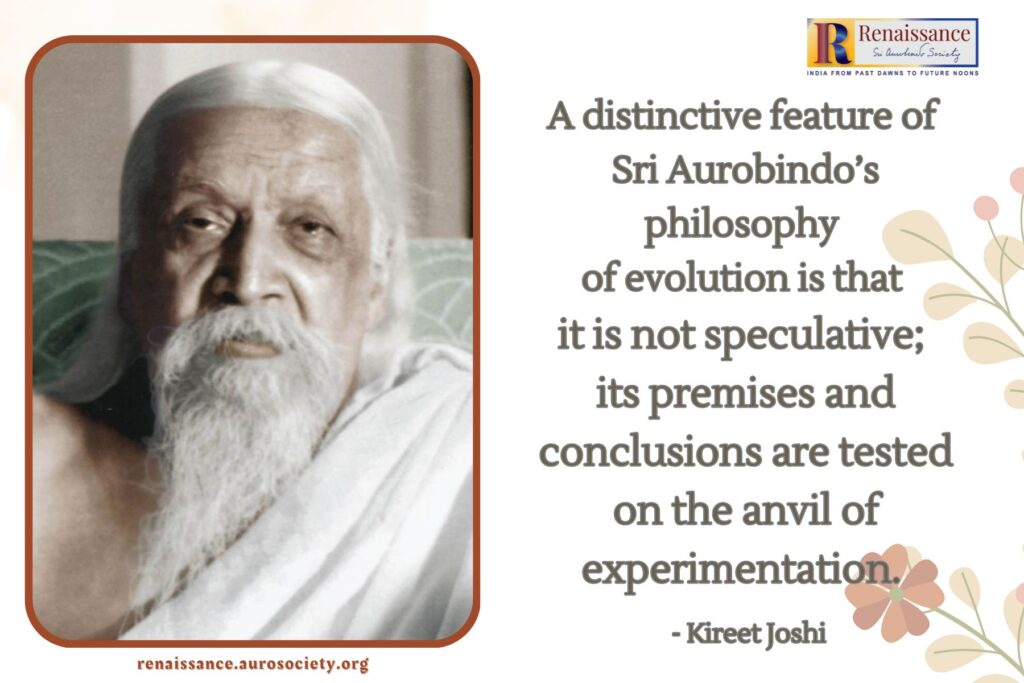Volume II, Issue 2
Author: Beloo Mehra
Continued from Part 1

In this second part we highlight a few insights from Sri Aurobindo on the true relationship between a Guru and a disciple, as well as the reason why we have so many gurus.
The True Relationship between the Guru and Disciple
The first requirement is a complete acceptance.

In one of his letters, Sri Aurobindo explains the relation between a Guru and disciple very simply and precisely – it is the relationship of a learner to a master, a learner who wants to learn not only the right thing but also the right way of doing the right thing. He writes:
One has to learn from the master and act according to his instructions because the master knows the subject and how it is to be learnt—just as in spiritual things one has to follow the Guru who has the knowledge and knows the way. If one learns all by oneself, the chances are that one will learn all wrong.
What is the use of a freedom to learn wrongly? Of course if the pupil is more intelligent than the master, he will learn more than the master, just as a great spiritual capacity may arrive at realisations which the Guru has not—but even so, the control and discipline in the early stages is indispensable.
(CWSA, Vol. 29, p. 192)
What is generally asked of the disciples is a complete surrender to the Guru. This in itself is sādhanā, because true surrender only happens progressively.
When one takes sincerely to surrender, nothing must be concealed that is of any importance for the life of the sadhana. Confession helps to purge the consciousness of hampering elements and it clears the inner air and makes for a closer and more intimate and effective relation between the Guru and the disciple.
(ibid, p. 193)
Sri Aurobindo explains that in Indian tradition surrender to the Guru is said to be surrender beyond all surrenders because through it one surrenders not only to the impersonal, but also to the personal, not only to the Divine in self but to the Divine outside oneself.
…you get a chance for the surpassing of the ego not only by retreat into the self where ego does not exist, but in the personal nature where it is the ruler.
(ibid, p. 193)
However, he also makes an important distinction between surrender to the Divine and surrender to the human Guru, when he writes –
In surrendering to the Guru, it is to the Divine in him that one surrenders—if it were only to a human entity, it would be ineffective. But it is the consciousness of the Divine Presence that makes the Guru a real Guru, so that even if the disciple surrenders to him thinking of the human being to whom he surrenders, that Presence will still make it effective.
(ibid, pp. 193-194).
It is the Divine Presence in the Guru that gives the disciple a deep sense of psychological shelter at the feet of the Guru, and at the same time builds his or her capacity for the path of sadhana. However, it must be remembered that what a sādhak can receive from the Guru is dependent on his or her state of receptivity.
What the Guru can do for the sadhak depends upon the latter’s receptivity—not upon any method or rule of sadhana. Certain psychological conditions or attitudes of the consciousness tend to increase the receptivity—e.g., humility towards the Guru, devotion, obedience, trust, a certain receptive passivity to his influence.
The opposite things—independence, a critical attitude, questionings—go the other way and make it necessary for the Guru to help only indirectly or behind the veil. But the main thing is a kind of psychological openness in the consciousness which comes or increases of itself with the help of the will to receive and the right attitude.
If there is that then it is not necessary to pull anything from the Guru, only to receive quietly. Pulling from him often draws untruly or things for which the consciousness is not ready to assimilate.
(ibid, p. 191)
The Guru’s touch or grace may open something in the disciple, but the difficulties of the disciple’s nature must still be worked out. Complete surrender is a quality of the inner psychic being, that spark of the Divine within us. And the more one is in contact with this inner psychic, these difficulties of outer nature begin to feel less as a burden or an obstacle but only as superficial imperfections which the working of the Guru’s grace will eventually remove.

Why So Many Gurus?
Another important point to emphasize when speaking of the Guru-shishya parampara is the diversity of spiritual paths, traditions, teachings, and lineages that make this parampara living and growing. This ever-expanding diversity is an inherent characteristic of Indian spiritual traditions, because infinite variety is the fundamental truth of human nature.
Different temperaments and natures seek differently, and that diversity in seeking is met by a diversity of paths to the inner journey. Yet this diversity is meaningful only when seen as a multitude of paths leading to the One and the Oneness that pervades all.
This Unity in Diversity is a key aspect of Indian spiritual traditions. And when combined with another truth of Indian traditions – that of the maximum spiritual freedom to approach the Divine – it has led to an unbroken chain of pursuit for spiritual realisation and attainment. The result has been a large number of gurus, enlightened masters and teachers offering a large number of paths, methods and practices.
The process by which a seeker finds the right guru is often a deeply personal one, and something that is generally not explainable through logic. It will be perhaps correct to say that in most cases it is not the seeker who finds the Guru, but rather the Divine through the Guru or the Divine in the Guru who seeks out his or her disciples and facilitates a sort of meeting of souls.
However, in some cases people may also end up choosing a Guru simply because their parents or grandparents were aspirants on that particular path.
It is highly relevant here to listen once again to the words of Sri Aurobindo:
All true Gurus are the same, the one Guru, because all are the one Divine. That is a fundamental and universal truth. But there is also a truth of difference; the Divine dwells in different personalities with different minds, teachings, influences so that He may lead different disciples with their special need, character, destiny by different ways to the realisation.
Because all Gurus are the same Divine, it does not follow that the disciple does well if he leaves the one meant for him to follow another. Fidelity to the Guru is demanded of every disciple, according to the Indian tradition.
“All are the same” is a spiritual truth, but you cannot convert it indiscriminately into action; you cannot deal with all persons in the same way because they are the one Brahman: if one did, the result pragmatically would be an awful mess.
It is a rigid mental logic that makes the difficulty but in spiritual matters mental logic easily blunders; intuition, faith, a plastic spiritual reason are here the only guides.
~ ibid, p. 194
CONCLUDED
Read Part 1 HERE.
~ Cover image: Painting by Priti Ghosh
Other design: Rishabh Sharma


